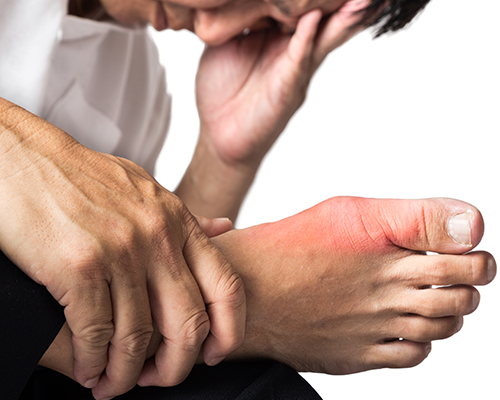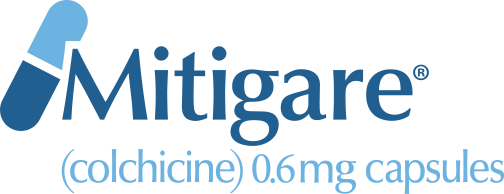
Gout is a painful form of inflammatory arthritis.1 Approximately 8.3 million Americans live with this disease.1 Gout usually appears first in the big toe, but can also affect the midfoot, ankles, knees, elbows, wrists and hands.2 In addition to swelling, gout can cause tenderness, redness and/or warmth in the affected joints, as well as lingering discomfort and limited range of motion.2,3 The condition happens when too much uric acid builds up in the body.2 Because the uric acid builds up over time, it may take months or even years for symptoms to arise.2
Initial attacks last between three to 10 days, and then months or years may go by before another attack occurs.4 Eventually, however, flares become more frequent and long-lasting.4 When this happens, patients may want to ask their doctors about how to help prevent gout flares. Preventive therapy may help ward off future attacks, which can help prevent damage to the joints.3,4
Who is likely to suffer from gout?
Gout remains a major and growing public health problem for many adult Americans—approximately six million men and two million women—it’s part of everyday life.1 Gout is more common in men than women until around age 60; experts believe natural estrogen protects women from the disease until they reach that age.5
Gout risk factors
A person is more likely to develop gout if he or she has a high level of uric acid in the blood.2 However, other factors may increase the likelihood of developing gout as well.6
Genes
For some people, gout is inherited.6 A 2009 study done at John Hopkins University on 12,000 people revealed a genetic cause for gout.7 Researchers uncovered a malfunctioning gene, which can lead to high concentrations of uric acid in the bloodstream.7
Health conditions
Pre-existing health conditions, such as high cholesterol, high blood pressure, diabetes and heart disease are associated with an increased risk of gout.6
Medications
Certain medications may increase the risk of gout. These include low-dose aspirin, diuretics (water pills) and immune-suppressing drugs.2
Diet
A person’s diet plays a major role when it comes to gout risk and prevention. Those who suffer from gout should avoid foods that are high in purines.8 Purines are chemical compounds found in some foods and drinks that the body breaks down into uric acid.8 Foods and drinks that are high in purines include6,8:
- Red meat
- Organ meats, including liver, kidney and sweetbreads
- Certain types of seafood, including shellfish, anchovies, herring, sardines, mussels, scallops, trout, haddock, mackerel and tuna
- Alcoholic beverages, especially beer
- White breads, cakes, candy and products made with high-fructose corn syrup
- Sugar-sweetened beverages
Drinking more water has been linked to fewer gout attacks.8 Eight to 16 eight-ounce glasses of fluid per day is recommended, with at least half of that being water.8 Talk with your doctor about appropriate fluid intake goals for you.8
Obesity
Obese people have a higher risk of gout and usually develop it at an earlier age.6 Gout risk increases as the body mass index goes up.2
Rapid weight loss
People who have undergone gastric bypass surgery are at a greater risk for gout.6 Crash diets and fasting also can trigger the disease.9
Stages of gout
According to the Arthritis Foundation, there are four stages of gout6:
- Asymptomatic hyperuricemia—Blood uric acid levels are higher than normal, but no symptoms are present.
- Acute gout, or a gout attack—Uric acid levels spike, triggering the gout attack. For most people, the attack happens during the night and intensifies over the next eight to 12 hours.
- Interval gout—The time between gout flares when there are no symptoms, but low-level inflammation may be damaging joints.
- Chronic gout—Attacks become more frequent and the pain does not subside as quickly as it once did. Joint damage may occur, which can lead to loss of mobility.
Symptoms of gout flares
At first, uric acid build-up in the blood may not cause any symptoms.6 When an attack occurs, however, the affected joint may become inflamed, swollen, red and intensely painful.2,3
Complications of gout
Most people who have had a gout attack will have another one between six months and two years later.2 Recurring attacks tend to last longer and affect more than one joint.2 If uric acid levels in the blood remain high, gout can become a chronic problem and help from a doctor may be necessary.
According to the Mayo Clinic, adults with gout can develop more severe conditions, including10:
- Recurrent gout—When gout attacks occur several times each year. If left untreated, gout can cause erosion and destruction of joints.
- Advanced gout—Untreated gout may cause tophi (TOE-fie) to develop under the skin. Tophi are deposits of urate crystals that can develop on the hands, feet, elbows or Achilles tendons. They are not usually painful, but can become swollen and tender during gout attacks.
- Kidney stones—When urate crystals collect in the urinary tract, they can cause kidney stones.
How gout is diagnosed
Doctors are often able to detect gout based on its symptoms—a painful, red, swollen joint is a fairly sure sign.2
Arthrocentesis, a procedure in which the affected joint has fluid drawn from it, is needed for a more definite diagnosis.2 If the fluid drawn contains urate crystals, the gout diagnosis is positive.2
What to do if you suspect you have gout
If you think you have gout, visit your doctor and talk about the symptoms you are experiencing. You may want to download and complete the Gout Flare Questionnaire (from resources for patients) before your appointment.
If you are diagnosed with gout, your doctor will probably recommend lifestyle modifications and may prescribe medication.
NOTE: This article was not written by a medical professional and is not intended to substitute the guidance of a physician. These are not West-Ward’s recommendations for gout flare prevention, but rather facts and data collected from various reliable medical sources. For a full list of resources and their attributing links, see below.
